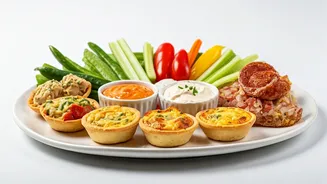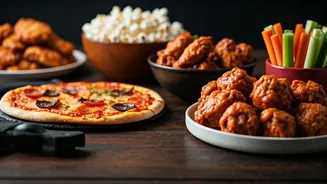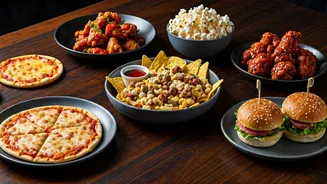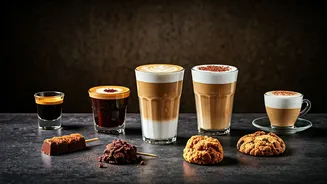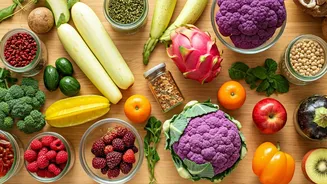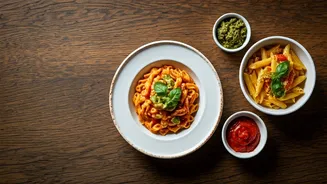Plate Selection Matters
Choosing the right plates is the cornerstone of any great party platter. Consider the size and shape; a variety is always a good idea. Offer a mix of round,
square, and rectangular platters to provide visual interest and cater to different food arrangements. Think about the material. Ceramic platters are classic and elegant, offering a neutral backdrop for colorful foods. Wooden boards bring a rustic charm and are perfect for charcuterie or cheese displays. Glass platters can showcase layered dishes, allowing guests to see the deliciousness. Think also about the occasion. Casual gatherings benefit from simpler options, while formal events might call for more elaborate platters. Always ensure the platters are clean and well-maintained. This simple step goes a long way in making a good impression. Consider using plates with raised edges to prevent food from sliding off, especially when serving saucy dishes. Investing in quality platters that are easy to clean and store will make your party planning a breeze and elevate the entire experience.
Food Arrangement Strategies
The arrangement of food on your party plate can significantly impact its appeal. Begin with the largest items, such as the centerpiece of a cheese board, or the main dishes. Place these items first, creating a visual anchor for your platter. Add smaller items next; use clusters of food to create visual interest. For instance, arrange crackers, nuts, or berries in groups rather than spreading them evenly. This approach adds depth and makes the platter more inviting. Vary the heights and textures of food to enhance visual appeal. Use elevated stands or bowls to add different levels. Alternate between smooth, crunchy, soft, and firm foods to stimulate guests' sensory experiences. Consider the color palette. Arrange foods to create a pleasing array of colors. Think of the bright green of herbs, the vibrant red of tomatoes, or the deep purple of grapes, and place them strategically to enhance visual contrast. Don’t overcrowd the plate. Leave some space between items to make them appear more appetizing and easier to pick up. Using garnishes can add a finishing touch. Sprigs of fresh herbs, edible flowers, or lemon slices will elevate the platter. Consider the flow. Arrange the food in a circular or flowing pattern to guide the eye and make the platter more appealing.
Perfect Food Selection
The key to a successful party plate is the selection of delicious and crowd-pleasing foods. Offer a variety of options to cater to different tastes and dietary requirements. Include a mix of flavors, textures, and ingredients to keep things interesting. Cheese is a must. Provide a selection of hard, soft, and flavored cheeses like cheddar, brie, and goat cheese. Pair these with crackers, breadsticks, and fruit preserves. Cold cuts are always a hit. Offer a variety of cured meats such as salami, prosciutto, and ham. Arrange these artistically alongside olives, pickles, and marinated vegetables. Include dips and spreads. Prepare different dips such as hummus, guacamole, and salsa. Serve these with pita chips, tortilla chips, and vegetable sticks. Add some healthy options to the mix. Include fresh fruits and vegetables like grapes, berries, carrots, and celery. Consider options like mini quiches, spring rolls, and samosas for warm options. Remember to label each item so guests know what they are eating. This is particularly important if you have any foods containing common allergens.
Prepping and Serving Tips
Successful party platters involve careful preparation and elegant serving. Plan ahead and prepare as much as possible in advance. Chop vegetables, marinate meats, and prepare dips ahead of time to reduce stress on the party day. Chill your platters before arranging the food. This will help keep the food fresh, especially items like cheese and cold cuts. Use parchment paper or serving utensils to prevent cross-contamination and make it easy for guests to serve themselves. Consider portion sizes; prepare single servings or small bites to make it easier for guests to sample everything without taking too much. Refill platters regularly, and clear away empty dishes to keep the presentation fresh and appealing. Keep hot foods hot and cold foods cold. Use warming trays or chafing dishes for warm items and ice or chilled serving platters for cold ones. Offer a variety of beverages to complement the food. Serve soft drinks, juices, and water, along with some alcoholic drinks if desired. Providing napkins and cutlery is also a must for convenient service. Consider the ambiance to enhance the entire experience by playing background music, dimming the lights, and decorating the serving area to create a welcoming atmosphere.
Platter Theme Ideas
Theme parties can elevate your house get-together. Create a Mediterranean platter with hummus, olives, feta cheese, pita bread, and grilled vegetables. For a taco night, assemble a platter with seasoned ground beef, shredded chicken, tortillas, all the taco toppings. Prepare an Italian-themed platter, with a variety of cured meats, cheeses, olives, and bruschetta. Create a dessert platter, featuring cookies, brownies, candies, fresh fruits, and small pastries. Build a charcuterie board with cured meats, cheeses, crackers, and fruits. Another idea is the brunch platter: offer pancakes, waffles, fresh fruit, breakfast meats, and yogurt parfaits. With a bit of creativity, you can create a platter that’s both beautiful and delicious. Ensure the food choices align with your guests' preferences and any dietary restrictions to make sure everyone is able to enjoy the meal. Consider seasonal themes; a Halloween-themed platter with spooky snacks or a Christmas platter with festive treats. The possibilities are endless, making each gathering unique and memorable.
